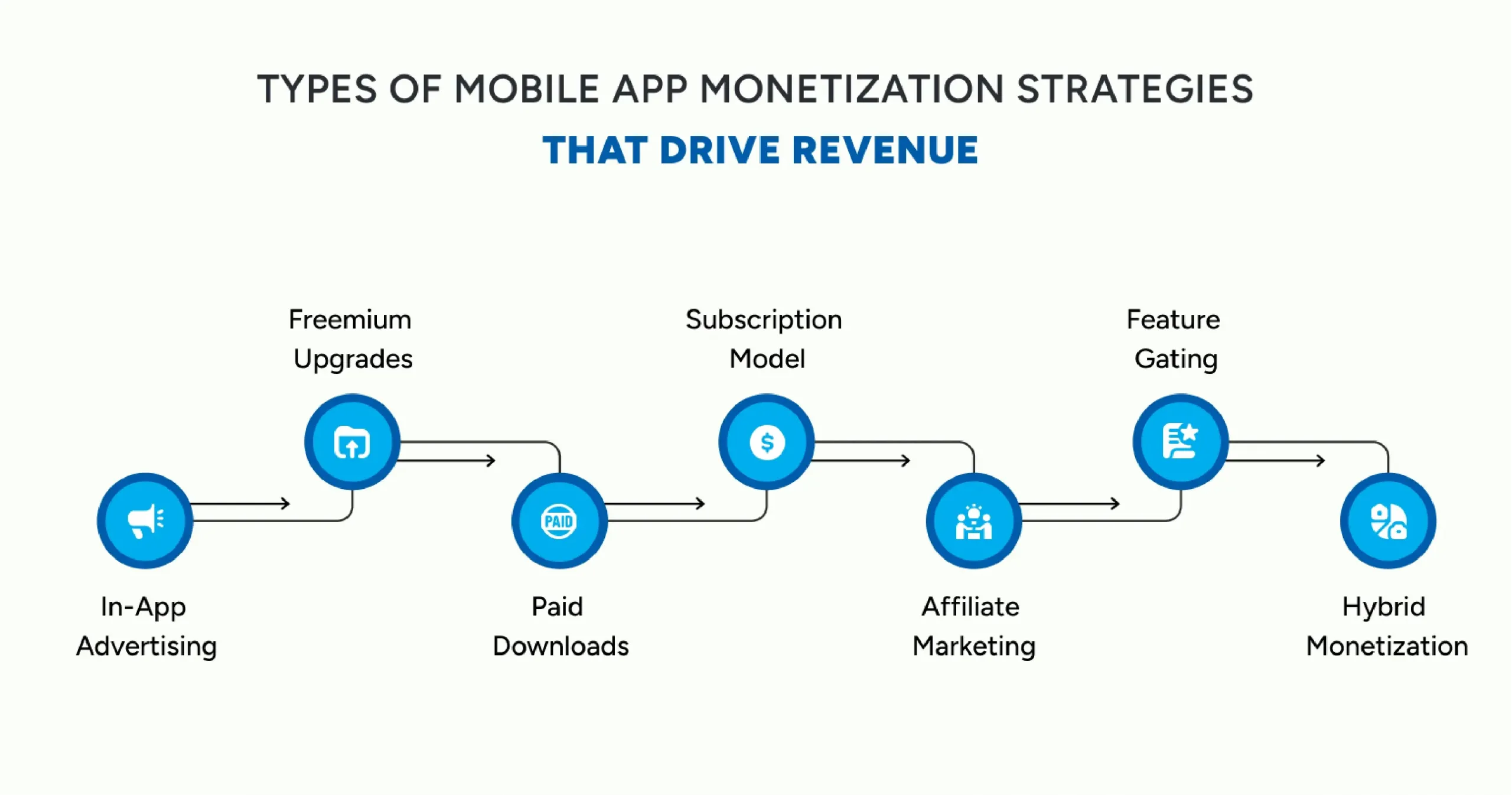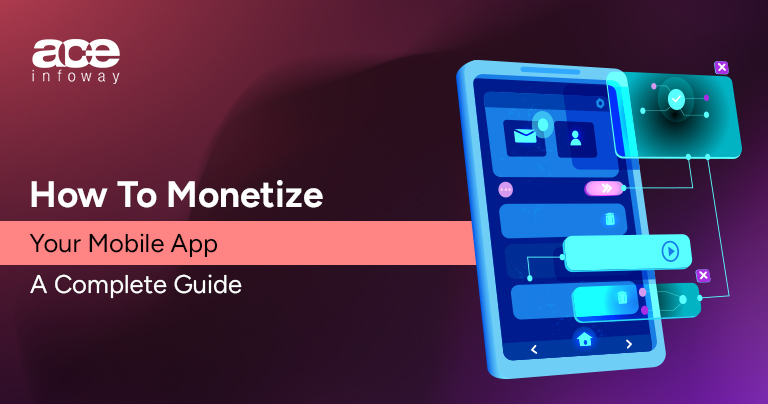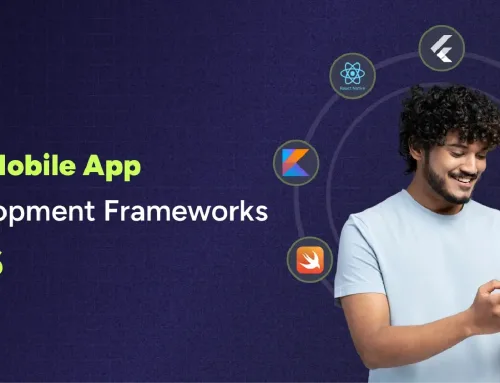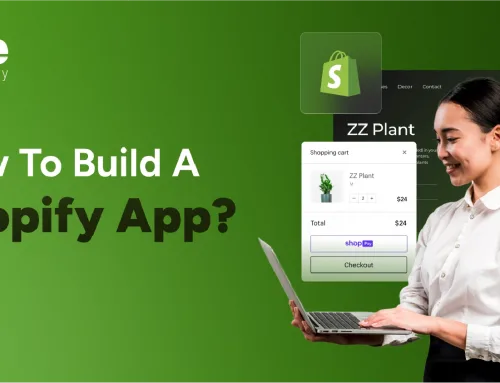Table of Contents
Having a brilliant mobile app idea and having the best mobile app development team doesn’t guarantee a successful mobile app, and it is not that straightforward. You need to plan a strategy and find out the smartest way to make it a profitable and revenue-generating mobile app. Many developers are still experimenting with different permutations and combinations to monetize their apps, while a few manage to hit the jackpot overnight.
The truth is, developing, scaling, and monetizing a mobile app is not an easy task, but with the right mobile app monetization strategies, it’s absolutely achievable.
Nowadays, millions of apps compete only for user attention, downloads, buzz around the internet and social media, but apart from that, you need a clear plan for sustainable growth. This is where mobile app monetization steps up. The right strategy can turn an app from a short-lived win into a steady business, boosting revenue while keeping the user experience intact.
In this blog, we’ll explore proven, data-backed strategies to help developers and stakeholders effectively monetize their apps, stay competitive, and scale with confidence.
What Is Mobile App Monetization?
Mobile app monetization is the process of transforming your app from a product into a sustainable business. It’s how developers generate revenue from their user base, no matter whether the app is free or paid. Sighting the competitive digital ecosystem we are observing currently, relying solely on downloads won’t keep your business afloat. To truly thrive, you need the right mobile app monetization models that align with your audience, app category, and long-term goals.
At its core, app monetization is about creating value for users while earning revenue in return. From in-app purchases and premium upgrades to ads and subscriptions, there are multiple ways to monetize mobile apps effectively. The key lies in balance, ensuring that your revenue streams enhance the user experience instead of disrupting it. When done strategically, app monetization not only fuels profitability but also strengthens user loyalty, turning your app into a scalable, revenue-generating ecosystem.
Why Mobile App Monetization and Its Strategies Are Important?
Building an app downloaded, appreciated, and loved by users, offering an engaging experience, is an achievement that thousands of app fail at, but turning that app into a sustainable business is where the real challenge begins. A clear and effective mobile app monetization strategy doesn’t just bring in revenue; it keeps your app alive, growing, and competitive in the ever-expanding digital marketplace.
Here are key factors that explain why you need to monetize mobile apps:
1. Unlock Massive Revenue Potential
The global mobile app industry is booming, projected to generate over $935 billion in revenue by 2025. This growth isn’t driven by downloads alone but by smart mobile app monetization models like in-app purchases, subscriptions, and ad-based revenue streams.
Even capturing a small fraction of this market can translate into substantial income. The question isn’t whether monetization works; it’s whether your app is ready to tap into it.
2. Sustain and Scale Your App’s Growth
App development is just the start. Between maintenance, feature updates, and marketing, expenses can quickly add up. Without a reliable revenue model, even great apps risk stalling.
Strategic mobile app monetization strategies help you recover costs, reinvest in improvements, and maintain steady growth. Monetization is about ensuring your app continues to evolve and deliver value over time rather than conceiving it as a revenue-generating only.
3. Enhance User Retention and Experience
When done right, monetization doesn’t frustrate users; it engages them with a better app experience. Think of freemium apps or premium upgrades that offer genuine value. Users who invest in your app through subscriptions or in-app purchases are more likely to stay loyal.
Some of the Successful brands like Spotify, Netflix, and Candy Crush thrive because they balance revenue generation with exceptional user experiences. Their smart use of mobile app monetization models funds innovation and feature development that keeps users coming back.
With the right mix of mobile app monetization strategies, you can create a profitable ecosystem where your users are happy, your app keeps improving, and your business continues to grow sustainably.
Different Types Of Mobile App Monetization Strategies And Models
When it comes to how to monetize mobile app projects effectively, there’s no one-size-fits-all answer. Each app has a unique target audience, purpose, and engagement pattern that shapes which approach will help in yielding the best results. The smartest mobile app monetization strategies align seamlessly with user expectations and business goals.
Let’s explore the top and best mobile app monetization models and strategies:
1. Display In-App Advertisements
In-app advertising allows developers to offer their apps for free while generating revenue by showing ads to users. These ads can appear as banners, pop-ups, native ads, or rewarded videos. With this approach, users watch short clips to unlock special features or bonuses. The idea is simple: users get free access to the app, and in return, developers earn money every time an ad is viewed or clicked. This model is especially powerful for apps with high daily active users (DAUs), as ad revenue is directly tied to user engagement volume.
Why it works:
Advertising remains one of the most scalable and proven mobile app monetization models, growing alongside global smartphone usage. It gives users an affordable (often free) experience while allowing app owners to maintain profitability.
Key considerations:
Balance is critical. Too many intrusive ads can harm retention, so test placements and formats to find what feels natural and non-disruptive.
2. Convert Free Users Through Freemium Upgrades (In-App Purchases)
The freemium model is a hybrid between free and paid access. Users can download and use your app at no cost but are offered optional premium features, digital goods, or exclusive content via in-app purchases (IAPs). These purchases could include extra lives in a mobile game, advanced design tools in a productivity app, or special templates in a creative app. It’s all about giving control to users as they decide if they want to upgrade and when they want to upgrade.
Why it works:
This strategy reduces the barrier to entry, helping you attract a larger audience while still monetizing your most engaged users. Once users experience genuine value, they’re more willing to invest in enhanced features or content.
Key considerations:
Design your upgrade flow carefully. Offer enough free features to hook users but reserve premium experiences that feel genuinely worth paying for.
3. Paid App Downloads
With this model, users pay an upfront, one-time fee before downloading your app from the app store. It’s the most straightforward way to monetize mobile apps as there are no ads or in-app purchases. This approach is often preferred by brands with strong reputations or apps that offer niche, high-value functionality (like professional tools, education platforms, or premium lifestyle apps).
Why it works:
Paid apps attract users who are more serious and invested, leading to higher engagement and retention. The upfront payment also ensures immediate revenue, making it easier to forecast income and plan growth.
Key considerations:
Since most users expect apps to be free, your app must clearly justify its price. Use marketing, reviews, and social proof to communicate its unique value.
4. Build Recurring Revenue with Subscription Models
The subscription model allows users to pay a recurring fee that can be weekly, monthly, or annually, allowing them to access exclusive features, premium content, or an ad-free experience. Apps in categories like fitness, news, entertainment, and productivity often thrive on this approach. Subscriptions turn one-time users into loyal, long-term customers, offering consistent and predictable income streams for developers.
Why it works:
Recurring payments mean recurring engagement. When users see ongoing value like new features, content updates, or exclusive perks, they’re more likely to renew their subscriptions.
Key considerations:
This model only works if users interact with your app frequently. Keep delivering value to maintain retention and reduce churn.
5. Earn Commissions with Affiliate Marketing
Affiliate monetization involves promoting third-party products or services within your app and earning a commission for every purchase made through your affiliate links. For example, one fitness app might recommend workout equipment, while a travel app might suggest hotels or tours. These recommendations are seamlessly integrated into the user experience, allowing your app to generate passive revenue while providing users with relevant and helpful suggestions.
Why it works:
It’s a win-win approach for both as you earn commission, and users get convenient access to trusted products or services that enhance their experience. For example, apps designed to gather audience insights, like our Mobile App for Marketing Survey which show how strategic data collection can complement monetization while improving user engagement and business decision-making.
Key considerations:
Stay authentic. Only promote offers that align with your app’s niche and audience trust. Misaligned or excessive promotions can harm credibility.
6. Offer Exclusive Features via Paywalls (Feature Gating)
Paywalls or “feature gating” mean limiting access to certain features, tools, or content until users pay or subscribe. This strategy is effective for apps where advanced functionality provides extra value, like additional filters in a photo app, deeper analytics in a productivity app, or ad-free streaming in an entertainment platform. It helps you segment casual users from power users and encourages natural progression toward premium plans.
Why it works:
Feature gating builds curiosity and motivation. Users experience your app’s value firsthand before choosing to unlock more through payment, which often leads to higher conversion rates.
Key considerations:
Timing matters. Introduce paywalls strategically, ideally when users hit natural points of engagement or desire more functionality, not too early in their journey.
7. Combine Multiple Models for Hybrid Monetization
The hybrid model combines multiple mobile app monetization strategies, such as subscriptions, ads, and in-app purchases, to diversify revenue streams. For example, an app might offer free access supported by ads, with the option to remove ads through a subscription or buy exclusive content via in-app purchases. This flexible approach ensures you’re not relying solely on one income source and allows you to serve a wider range of user preferences.
Why it works:
Different users have different spending habits. Some prefer consistent subscription access, while others make one-time purchases or tolerate ads. The hybrid approach maximizes reach and profitability.
Key considerations:
Avoid over-monetization. If users feel nickel-and-dimed, they may abandon your app entirely. Transparency and balance are key.
Mastering how to monetize a mobile app effectively takes testing, patience, and audience insight. The most successful developers don’t chase every model; they refine the ones that align best with their app’s purpose and user behavior. When done right, your app doesn’t just generate downloads it generates dependable and long-term revenue.
Which Monetization Model Is Best for Your App?
Choosing one right mobile app monetization strategies can make the difference between a thriving app and one that struggles to stay afloat. There’s no universal formula for success; the key lies in understanding your app’s purpose, target audience, and market position. To monetize mobile apps effectively, developers often experiment with a mix of models that align with user behavior and long-term growth goals.
Here are the key considerations to select the most suitable and effective mobile app monetization strategies and models:
1. Understand What Your App Does
Before you decide how to monetize a mobile app, step back and analyze its core purpose. What value does it offer? What problems does it solve? Apps that deliver ongoing content, such as entertainment, news, or productivity tools, tend to perform well with subscription models. On the other hand, gaming apps often thrive through in-app ads and micro-transactions that keep players engaged without upfront costs. The right fit depends on the nature of your app and the experience you want to create for users.
2. Research Your Competitors
If you want to monetize mobile apps with their complete potential, understanding your competitors is essential. Analyze what similar apps in your niche are doing to generate revenue. Are they relying on ads, offering premium tiers, or encouraging in-app purchases? Competitive analysis not only helps you identify what works but also where you can innovate. Sometimes, blending multiple mobile app monetization strategies, like combining freemium access with ad-free upgrades, gives your app the perfect balance of accessibility and profit.
3. Know Your Target Audience
Even the most creative monetization model will fall flat if it doesn’t resonate with your audience. Successful developers know who their users are, what they value, and what they’re willing to pay for. For example, younger users might tolerate ads if it means free access, while business professionals may prefer ad-free premium options. The deeper your insight into your audience, the more precisely you can monetize mobile apps for long-term success.
4. Adopt a Flexible Approach
Mobile app monetization strategies and approaches evolve as your app grows and market trends shift. What works during the launch phase might not deliver the same results later. Regularly reviewing performance data and adapting your strategy is vital to staying profitable in an ever-changing digital economy.
Conclusion
The best app monetization model is the one that fits your app’s mission, audience expectations, and long-term vision. A thoughtful, data-driven approach to how to monetize a mobile app will ensure your product not only earns but endures. Whether you are launching a new app or want to monetize from the existing app, you can contact us to know how to monetize a mobile app with the best monetization model.
FAQs
What is the most profitable way to monetize mobile apps?
The most profitable way to monetize mobile apps depends on your audience and app type. Subscription-based mobile app monetization models and freemium upgrades are leading, as users prefer flexibility and ongoing value over one-time purchases.
How do I choose the right mobile app monetization strategy for my app?
Start by analyzing your target users, app category, and engagement levels. The best mobile app monetization strategies align user behavior with value delivery. For instance, gaming apps often rely on in-app ads, while productivity apps perform better with subscription models.
How does user experience impact mobile app monetization success?
A seamless user experience is key to successful mobile app monetization. Intrusive ads or poorly timed paywalls can frustrate users. Prioritize balance, your monetization efforts should enhance engagement, not disrupt it.
What mistakes should developers avoid while monetizing mobile apps?
Common mistakes include overloading apps with ads, ignoring user feedback, and not testing different mobile app monetization models. Developers should also avoid choosing strategies that don’t match their app’s purpose or audience.
Are there specific monetization models for niche apps or startups?
Yes. Startups and niche apps often benefit from tailored mobile app monetization strategies such as affiliate marketing or micro-subscriptions. These models allow gradual growth without alienating early users.


























